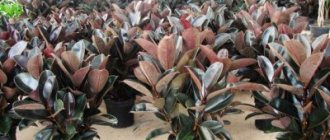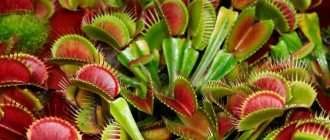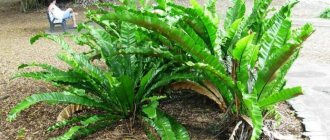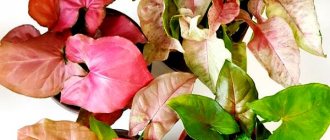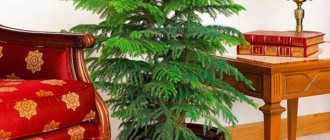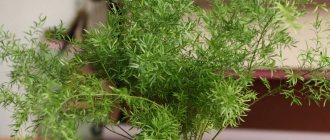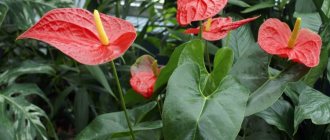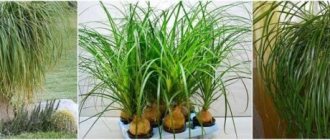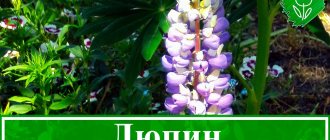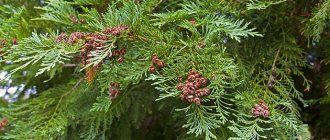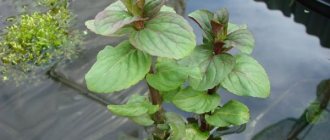Among all flowering crops, the largest genus is that of the plant Rusanovka from the Asteraceae family. According to various sources, there are from 1000 to 3000 varieties. They are distributed across all continents and can be an annual herb or a huge tree.
Author of the article
Eleonora Borisova
Specialist in medicinal plants and their use in folk medicine.
All plants differ not only in size, but also in properties. Consider the common groundsel, which is found everywhere and is a weed.
We also recommend reading about another useful medicinal plant - Eyebright.
Large tongue
Large-tongued groundsel - False ivy - Seneciomacroglossus.
Leaf succulent is a long-lived plant with creeping stems. The shoots can reach 1.5-3 m in length, branch slightly and slowly become woody.
The silhouette of the leaf blades follows the outlines of the spearhead and the leaves of true ivy. The inflorescences are on a long peduncle, very similar to field daisies. They have a yellow fuzzy center and light petals around them.
The variety Variegatus is distinguished by its two-colored leaves. Their dark green surface is painted with contrasting straw or smoky spots of arbitrary shape and location.
Flat-leaved
Flat-leaved - Senecio rhombifolius - Seneciorhombifolius.
Herbaceous medicinal perennial with tall, even stems.
The rhizome is steep, located in the upper layer of soil. The shoots are finely ribbed and dotted with an abundance of short hairs.
The leaves are elongated and wide, heart-shaped.
Lush inflorescences are corymbose corymbs consisting of a bunch of tiny lemon flowers.
After them, the fruit is formed in the form of a stretched cap.
Read more about the care, collection, drying, storage of flat-leaved groundsel, as well as its use in medicine, here.
Contraindications
In addition to the healing properties, there are many side effects. Therefore, before taking drugs based on ragwort, you need to find out about the contraindications.
Attention! The plant should not be used in any form by children under 16 years of age, pregnant women and nursing mothers.
- Long-term use of drugs is also unacceptable: problems with the liver and nervous system may begin. Not for: patients with gastrointestinal pathologies, those who are sick with both acute and chronic diseases of the kidneys and adrenal glands.
- Do not use any medications for low blood pressure or diseases of the eyeball.
Since the ragwort plant is toxic and has contraindications, the frequency of administration and amount of the drug should be asked from the attending physician or specialist. If you feel signs of poisoning or illness associated with taking the drug, you should urgently go to the clinic.
The plant does not need planting or care. It grows on its own. Used as a medicinal herb for diseases. Has many contraindications. This is the kind of ragwort that grows like a weed.
Yakobeya Yakov
Jacobea Jacobea - Meadow glue - Seneciojacobaea - Jacobea vulgaris.
A very tall herbaceous plant, the stems of which can grow up to a meter in length.
The stems are bare or with very weak cobweb-like pubescence.
The leaves have an extremely bizarre shape, changing depending on their location.
The inflorescences, composed of small flowers, similar to cornflower, are collected in corymbose brooms or braids.
The number of petals can vary from 3 to 7. They are painted yellow-orange.
How to replant a flower
The description of the flower states that young specimens require annual replanting, and older specimens are replanted less frequently, as needed, approximately once every 2 or 3 years.
You can purchase a ready-made substrate or prepare it yourself by mixing sand with leaf soil. If you prepare the soil yourself, you must warm the sand to kill all the bacteria in it.
Expanded clay or drainage is placed at the bottom, which will help remove excess moisture. The substrate is poured onto the expanded clay, and the groundsel is transferred from the old pot to the new one. All that remains is to add soil to the required amount and lightly compact it so that the plant is securely fixed in the pot.
Common groundsel
Common ragwort - Golden ragwort - Seneciovulgaris.
A ubiquitous herbaceous pest.
It has thickened, erect stems with a smooth outer layer.
The leaf blades are large and elongated, usually elongated with lobes and marginal teeth.
The inflorescences are small, inconspicuous, bloom at the very top.
Amber tubular flowers are surrounded by a layer of emerald scales.
It is not only a noxious weed, but also toxic to animals.
At the same time, it contains substances that have hemostatic properties.
Medicinal properties
The whole plant is used for medicinal purposes and can be collected all summer long. The grass should be dried in the shade, but with ventilation.
Beneficial substances found in the plant:
- ascorbic acid;
- seneciphilin;
- alkaloids;
- routine;
- senecionine;
- mineral salts.
In folk medicine, Senecio is used both externally and orally (internally).
Preparations containing this plant are used to stop bleeding and speed up wound healing.
When used orally, small doses of decoctions and tinctures stimulate the central nervous system.
But if the norm is exceeded, the effect will be the opposite.
The substances contained in ragwort have antispasmodic and wound-healing, hypotensive and anti-inflammatory effects.
Gluing is also used to treat stomach and duodenal ulcers, and is especially effective for internal bleeding.
Inflammatory processes in organs such as:
- large and small intestines;
- gallbladder.
Ash cineraria
Ashy cineraria - Jacobaeamaritima - Silver or seaside cineraria.
An evergreen semi-shrub or shrub plant of modest size, not exceeding 50-60 cm.
Leaf blades are simple, heavily dissected.
They are painted in malachite color, which is almost invisible under the steel coating that covers the entire surface of the plant.
The flowers are small, look like daisies, and form baskets together.
The color of the petals is golden.
The leaves contain the compound seneciphylline, which perfectly relaxes muscle fibers.
The plant is used in outdoor interior design.
Artemisia
Artemisia ragwort - Carpathian Senecio - Senecioabrotanifolius.
A herbaceous perennial with low straight stems growing 20-35 cm in height.
Shoots can grow upward or horizontally, and slightly branch.
The leaves consist of a cluster of thin stripes, which is why they appear fluffy.
From 2 to 6 single flowers appear at the tip of each stem.
From the shaggy, carrot-colored center, sunny-colored petals extend downwards.
Cultivated for decorating gardens and alpine hills.
Senecio vulgaris - growing and care at home
Rowley's ragwort Senecio rowleyanus - what kind of flower
Because of its beneficial properties, ragwort is often grown in garden plots. Since it is a wild herb, certain requirements must be met.
Lighting and temperature
Flat-leaved, common and other varieties of ragwort love good lighting. You should not grow them under direct sunlight - the leaves and buds can get burned. Planting in the shade will cause the bush to stretch upward. It is best to grow the flower on the east or west side of the house.
Plant the plant in the partial shade zone
The temperature regime required by the plant changes throughout the year. In summer – 25-30 ℃. By winter, the temperature is gradually reduced to 8-15 ℃.
It is important to know! If you do not comply with the temperature requirements, the plant will age prematurely and begin to shed its leaves.
Watering and humidity
Raspberry tolerates drought well, so there is no need to spray it. Carry out only for medicinal purposes. In this case, the flower pot is placed at a remote distance from radiators and heaters.
Common, riverside and false arnica are succulents. They can accumulate moisture in their leaves. Watering too frequently leads to rotting of the bush. In spring and summer, it is recommended to moisten the soil 2 times a week; in the fall, the number of procedures is reduced, and in winter it stops completely. Water the flower with settled soft water.
Fertilizing and soil quality
It is best to plant a flower in a substrate intended for succulents and cacti. The soil should be slightly acidic, nutritious, with a large amount of useful elements, loose, water- and breathable.
The substrate can be purchased at the store or made independently from the following components:
- turf land;
- leaf soil;
- coarse sand.
Charcoal is added to the finished mixture. It is recommended to apply fertilizers to the bush from the beginning of March to the beginning of September. Complex formulations with a low nitrogen content are suitable for this. Fertilizing is applied no more than once a month.
Additional Information! The groundsel is suitable for feeding intended for orchids and cacti.
Fertilizers suitable for ragwort
Choosing a pot
To plant ragwort, it is important to choose the right container. The pot should be wide and shallow. The material from which it is made must be porous so that the root system has sufficient air exchange. It is preferable to choose glazed ceramic pots with a drainage hole at the bottom.
Ivy-shaped
Ivy ragwort - Senecioangulatus.
Guest from South Africa. An unpretentious, fast-growing plant with creeping shoots is often bred as a hanging plant.
The stems are plump and juicy, rich dark green or chestnut-red in color, densely leafy.
The leaf blades, growing, form a continuous carpet without the slightest gap.
They are distinguished by their noble pistachio coloring in deep tones, and outwardly they are hardly distinguishable from ivy itself.
The inflorescences are umbellate, multiple, intense saffron color.
Granta
Grant's ragwort - Seneciograntii.
Perennial succulent with thick roots - tubers.
The stems are fleshy, stretch upward, but under their own weight they bend and begin to crawl along the ground.
The leaves are oval, the petiole is widened, and the tip is pointed.
They are painted in a faded olive color; young ones are distinguished by a purple layer, which soon disappears.
During flowering, it delights with spherical inflorescences of bright color - tangerine or carmine.
Reproduction
The method of propagation of the ragwort depends on its lifespan. Annual individuals reproduce by seeds. Perennial - by layering or cuttings.
Propagation by seeds
Propagation by seeds is carried out in the following sequence:
- To increase the chances of seed germination, they are pre-germinated. To do this, place it in warm water for several hours, then lay it out on cloth or paper and cover it with film. It is necessary to maintain a high level of humidity and temperature within 20-25 ℃ above zero. In about a week, the seeds will germinate.
- After this, they are planted in a container and covered with polyethylene to create a greenhouse effect.
- Regularly spray the seeds with a spray bottle. When the cotyledons begin to develop, the seedlings are planted in separate pots.
Cuttings
The plant is propagated using this method only after flowering has completed. To do this, a shoot 10 cm long is cut off and the lower leaves are removed from it. The cuttings are planted in a small pot and placed in a warm, well-lit place.
Layerings
Young bushes regularly form at the base of the groundsel. They are separated from the mother bush and planted in a pot as a full-fledged plant. You can simply bend a long shoot to the ground, secure it and cover it with earth. When it gives roots, it is separated from the main bush and planted separately.
Medley Wood
Medley-Wood's godson - Seneciomedley-woodi.
Another leafy succulent that forms small shrubs.
The shoots can grow 70-90 cm in height. The stems are thick, erect, and do not branch.
The leaves are fleshy and juicy, egg-shaped.
The color is light green, hidden under a matte silver coating.
The inflorescences are small, formed at the top of the shoot, reminiscent of daisy flowers.
The petals are bright yellow, the middle can be red, chestnut, or reddish.
Creeping
Creeping flower Senecioserpens.
Very low shrubs that gradually grow into a mat and densely cover the soil.
A perennial evergreen succulent that stores moisture in its leaves.
They are very fleshy, located on creeping stems. The plant is pale green and covered with a coating of gray and blue tones.
The inflorescences are milky-white baskets.
Growing in the wild
Common groundsel Senecio macroglossus
The herb ragwort grows naturally throughout Eurasia. Particularly common in the Asian and European parts. You can meet this plant in absolutely any conditions and places:
- in the meadows;
- in the garden;
- in forest plantations;
- in landfills;
- in the park area.
The grass is distributed throughout Eurasia
For your information! The plant prefers any type of soil except black soil.
Acanthofolia
Acanthofolia - Senecioachanthifolius.
Always a green bush, living for many years, settling only in well-lit areas.
The leaves are patterned, picturesque in appearance, and a silver shiny coating only enhances the impression.
The shrub is often used as a decoration for flower beds and front gardens.
Rowley
Rowley's ragwort - String of Pearls - Seneciorowleyanus.
A very popular houseplant with a very distinctive appearance. It has creeping or drooping stems, which is why this type of kleinia can be used as a ground cover or hanging plant.
The main advantage is the original leaf-balls that look like large beads.
When it blooms, it produces a snow-white ball with chocolate stamens sticking out in different directions.
Possible problems during cultivation
Improper care is dangerous for the development of many diseases and the occurrence of a number of problems:
- Drying and dying of leaves, as well as the appearance of brown marks on them, indicate that the plant is kept in too hot conditions. Poor watering and dry air may also be the reasons;
- brown spots on yellowed leaves are a rather dangerous symptom, indicating excess moisture and low air temperature. The lack of measures taken often leads to rotting of the entire root system;
- sparse and weakly growing leaves may indicate a lack of light, and dry and brown spots may indicate an excess of it;
- A change in plant color may occur due to a lack of nutrients.
As for pests, ragwort can be affected by spider mites, mealybugs and aphids. Insecticides will help against them.
Having discovered common groundsel on your site, you should not immediately remove it like a weed. This flower has a number of medicinal properties and has long been used in folk medicine. But we should not forget that its excessive use has its contraindications, so treatment should be carried out only with the consent of the attending physician. But as a decorative flower, the ragwort is an excellent option. The quantitative indicators of his supporters are growing every year.
Blanket 220x200 cm
1799 ₽ More details
Blanket 220x200 cm
999 ₽ More details
Wooden chairs
Articulated
Articulated gluena - Senecioarticulatus.
A deciduous shrub that looks like a succulent due to its very thick stems. Each is divided into small segments using constrictions.
When cut, the shoots are round and tend to branch heavily.
The leaves are carved, gray-green. Blooms with yellow corymbose baskets.
Common Pests and Diseases
The indoor flower Raspberry can be attacked by the following parasites:
- Pelargon aphid. Settles on young shoots, inflorescences and leaves. You can tell that the crop is damaged by yellow leaves and browned inflorescences. To destroy parasites, you will need to periodically spray the crops with warm water. In case of severe infestation, insecticides are used.
- Spider mite. The leaves turn brown and cobwebs appear on the underside. To destroy the culture, Actellik is used.
- Mealybug. Larvae appear on the leaves and feed on the sap of the succulent. The culture should be treated with a solution of soap or alcohol. In case of severe infection, use karbofos emulsion.
Among the diseases, the most common is powdery mildew. It will be necessary to remove damaged parts of the crop. The plant should be treated with foundation (1 gram of the drug per 1 liter of water). Bushes are also damaged by gray rot. Dry spots with a yellowish edge form on the leaves. Treatment is carried out with Copper Oxide.
taking root
Rooting glue - Senecioradicans.
Long creeping succulent.
The stems are thin, the leaves are fleshy and elongated.
They have points at both ends, a dark marsh color and longitudinal stripes.
During the flowering period, single white baskets appear on long peduncles.
